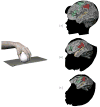Mirror neurons in the tree of life: mosaic evolution, plasticity and exaptation of sensorimotor matching responses
- PMID: 27862868
- PMCID: PMC5433930
- DOI: 10.1111/brv.12310
Mirror neurons in the tree of life: mosaic evolution, plasticity and exaptation of sensorimotor matching responses
Abstract
Considering the properties of mirror neurons (MNs) in terms of development and phylogeny, we offer a novel, unifying, and testable account of their evolution according to the available data and try to unify apparently discordant research, including the plasticity of MNs during development, their adaptive value and their phylogenetic relationships and continuity. We hypothesize that the MN system reflects a set of interrelated traits, each with an independent natural history due to unique selective pressures, and propose that there are at least three evolutionarily significant trends that gave raise to three subtypes: hand visuomotor, mouth visuomotor, and audio-vocal. Specifically, we put forward a mosaic evolution hypothesis, which posits that different types of MNs may have evolved at different rates within and among species. This evolutionary hypothesis represents an alternative to both adaptationist and associative models. Finally, the review offers a strong heuristic potential in predicting the circumstances under which specific variations and properties of MNs are expected. Such predictive value is critical to test new hypotheses about MN activity and its plastic changes, depending on the species, the neuroanatomical substrates, and the ecological niche.
Keywords: exaptation; homology; manual gestures; mirror neurons; mosaic evolution; neonatal imitation; plasticity; sensorimotor learning; tool-use.
© 2016 Cambridge Philosophical Society.
Figures



Similar articles
-
Two different mirror neuron networks: The sensorimotor (hand) and limbic (face) pathways.Neuroscience. 2017 Sep 1;358:300-315. doi: 10.1016/j.neuroscience.2017.06.052. Epub 2017 Jul 4. Neuroscience. 2017. PMID: 28687313 Free PMC article. Review.
-
Mirror neurons: from origin to function.Behav Brain Sci. 2014 Apr;37(2):177-92. doi: 10.1017/S0140525X13000903. Behav Brain Sci. 2014. PMID: 24775147 Review.
-
The mirror system in human and nonhuman primates.Behav Brain Sci. 2014 Apr;37(2):215-6. doi: 10.1017/S0140525X13002446. Behav Brain Sci. 2014. PMID: 24775172
-
Associative (not Hebbian) learning and the mirror neuron system.Neurosci Lett. 2013 Apr 12;540:28-36. doi: 10.1016/j.neulet.2012.10.002. Epub 2012 Oct 9. Neurosci Lett. 2013. PMID: 23063672 Review.
-
Auditory-Motor Matching in Vocal Recognition and Imitative Learning.Neuroscience. 2019 Jun 15;409:222-234. doi: 10.1016/j.neuroscience.2019.01.056. Epub 2019 Feb 10. Neuroscience. 2019. PMID: 30742962 Review.
Cited by
-
A New Neurorehabilitative Postsurgery Intervention for Facial Palsy Based on Smile Observation and Hand-Mouth Motor Synergies.Neural Plast. 2021 Mar 24;2021:8890541. doi: 10.1155/2021/8890541. eCollection 2021. Neural Plast. 2021. PMID: 33833792 Free PMC article.
-
Differential mirror neuron system (MNS) activation during action observation with and without social-emotional components in autism: a meta-analysis of neuroimaging studies.Mol Autism. 2020 Sep 29;11(1):72. doi: 10.1186/s13229-020-00374-x. Mol Autism. 2020. PMID: 32993782 Free PMC article.
-
Autonomic Responses to Emotional Stimuli in Children Affected by Facial Palsy: The Case of Moebius Syndrome.Neural Plast. 2019 Apr 8;2019:7253768. doi: 10.1155/2019/7253768. eCollection 2019. Neural Plast. 2019. PMID: 31093273 Free PMC article.
-
What Else Is Happening to the Mirror Neurons?-A Bibliometric Analysis of Mirror Neuron Research Trends and Future Directions (1996-2024).Brain Behav. 2025 Apr;15(4):e70486. doi: 10.1002/brb3.70486. Brain Behav. 2025. PMID: 40205860 Free PMC article.
-
EEG beta desynchronization during hand goal-directed action observation in newborn monkeys and its relation to the emergence of hand motor skills.Dev Cogn Neurosci. 2018 Apr;30:142-149. doi: 10.1016/j.dcn.2018.02.010. Epub 2018 Mar 1. Dev Cogn Neurosci. 2018. PMID: 29524845 Free PMC article.
References
-
- Amunts K, Schleicher A, Bürgel U, Mohlberg H, Uylings H, Zilles K. Broca’s region revisited: cytoarchitecture and intersubject variability. Journal of Comparative Neurology. 1999;412(2):319–341. - PubMed
-
- Anderson ML. Neural reuse: a fundamental organizational principle of the brain. Behavioral and Brain Sciences. 2010;33(04):245–266. - PubMed
-
- Arbib MA. The mirror system, imitation, and the evolution of language. In: Dautenhahn K, Nehaniv CL, editors. Imitation in animals and artifacts. Cambridge, MA: MIT Press; 2002. pp. 211–228.
-
- Arbib MA. From monkey-like action recognition to human language: An evolutionary framework for neurolinguistics. Behavioral and Brain Sciences. 2005;28(02):105–124. - PubMed
-
- Arbib MA. Tool use and constructions. Behavioral and Brain Sciences. 2012;35(04):218–219. - PubMed
Publication types
MeSH terms
Grants and funding
LinkOut - more resources
Full Text Sources
Other Literature Sources

